Nostalgia with a taste of vinyl

Once upon a time, when the trees were bigger, the grass is greener, the sky is pigeon (in a good, not yet mean sense of the word!), And the sun is brighter, I loved listening to vinyl!
Well, how - I loved ... When I wanted “beautiful”, I mean music, I turned on the turntable with a corundum needle and ...
There were few alternatives: tape recorders were (comparatively) expensive (and scarce), there was no Internet at all (ridiculous, was it?), They “turned” on the radio “classics” and on TV - “Morning mail” with “Pesnyary”, so vinyl discs, and in common parlance - records (or, in the jargon, "plasti"), were practically the only "folk" carrier of the "canned" sound in everyday life.
And, by the way, quite a high-quality and durable carrier! No wonder that now they have found a "second life" ...
It is a pity that they did not give in to copying (but we now understand this, and then there was no talk about copying). That is, of course, the "layers" could be "rewritten" to "reel" (reel), and later to a cassette tape recorder (and, by the way, for the preservation of vinyl, this should be done, but more on that below), but - see above, about the deficit ... But it was impossible to copy the record to the "blank disc", due to the lack of such (blanks, hehe!).
')
Since then, digital technologies and computers have tightly entered my life, music (video and books too) with any required quality has become possible to “download”, flash drives have become the size of a “sandwich”, and the cost of modern reproduction equipment has become “penny” ( I mean what is called "consumer goods", that is, what the broad masses of the people use, without touching the so-called "audiophile" devices).
But, once I had the opportunity to test a modern turntable, I immediately woke up the reflexes that were still dormant, setting me up in a nostalgic way.
So, the hero of this review is a completely fresh vinyl player, a May new product from ION Audio, LLC, an Air LP model with an integrated Bluetooth module.
ION Audio is not Chinese, as it may seem by its name, “sharashka in the basement of Uncle Liao”, but a well-known developer and manufacturer of consumer electronic music devices. ION Audio is a member of the private American group inMusic, founded in 2003 (this group also includes the companies Numark, Alesis, Akai Professional, M-Audio, MixMeister, SONiVOX, Alto Professional, Denon DJ, Denon Professional, Marantz Professional).
ION Audio has a professional development team that takes advanced technologies and turns them into complete solutions at affordable prices, allowing buyers to enjoy music in a new way, digitize classic recordings, and easily learn to play musical instruments. The ION Audio range includes 4 product groups: home discos, personal Open Air, turntables, musical instruments.
As stated in the enclosed manual (apart from the general brochure in several European languages, a separate thin brochure in Russian is also attached!), The ION Audio Air LP player has various “talents”: in addition to actually playing vinyl records at all three “speeds”, it It can also "give" the sound not only to the usual "tulips", but also to work with Bluetooth systems! That is, with my favorite Bluetooth headphones too!
He can also “digitize” music through a USB connection to a computer (using a special program), and you can listen through the computer’s audio system.
But that's not all: the player has a line input through which you can connect any tape recorder or player, and in the same way transfer its sound to Bluetooth-headphones or “digitize”.
There is something to test, thank God: there are a lot of Soviet-made records with rock and pop music, there are also a few pieces produced by the socialist camp, and although the latter are “at 78 turns”, they can also be listened to without any problems on this player.
The player came to me in the company's ION-new box of brownish corrugated packaging, from the inscriptions on which it follows that the weight of the contents is 3.43 kg., And with the packaging - 4.87 kg. There is also indicated a volume of 1.59 cubic feet (well, this is approximately the length and width of a standard keyboard, and 2 times less height) and the location of the ION Audio office is Cumberland .
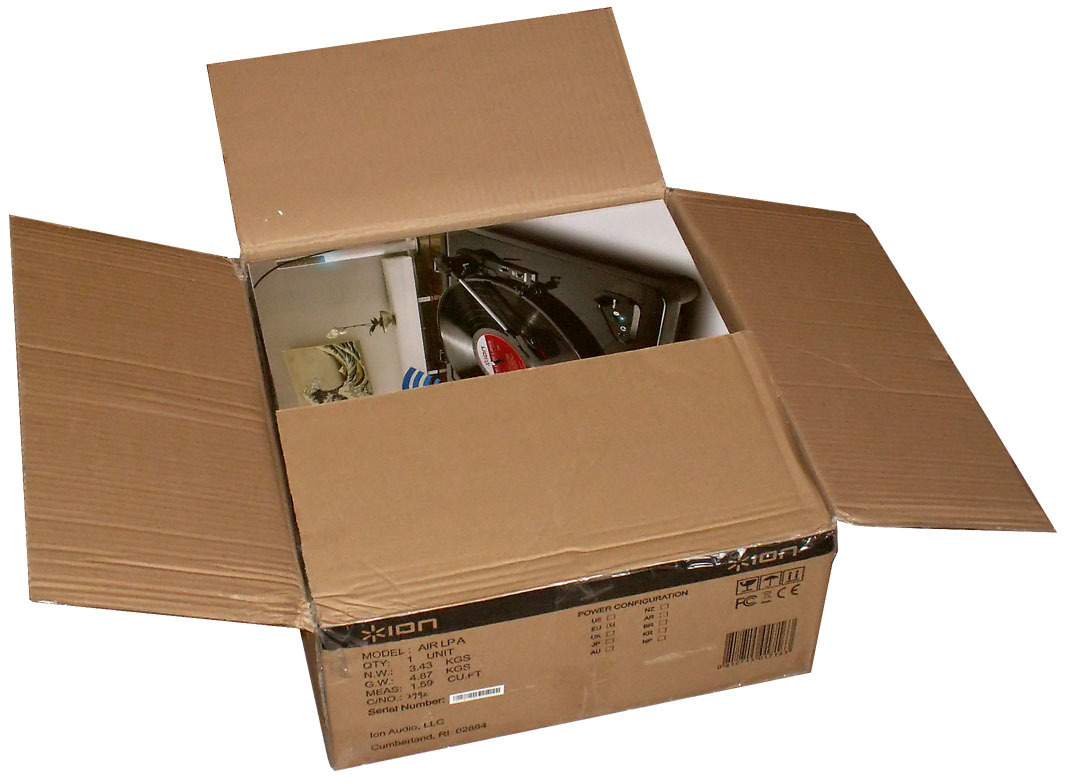
It is also noted that the model ION Audio AIR LP is made in the European version - this is true, the power adapter is well suited to our outlets.
Inside, the gray box was also branded, but already “beautiful”, a color box of coated corrugated cardboard, with a large image of a subject and a bunch of information on the bottom.
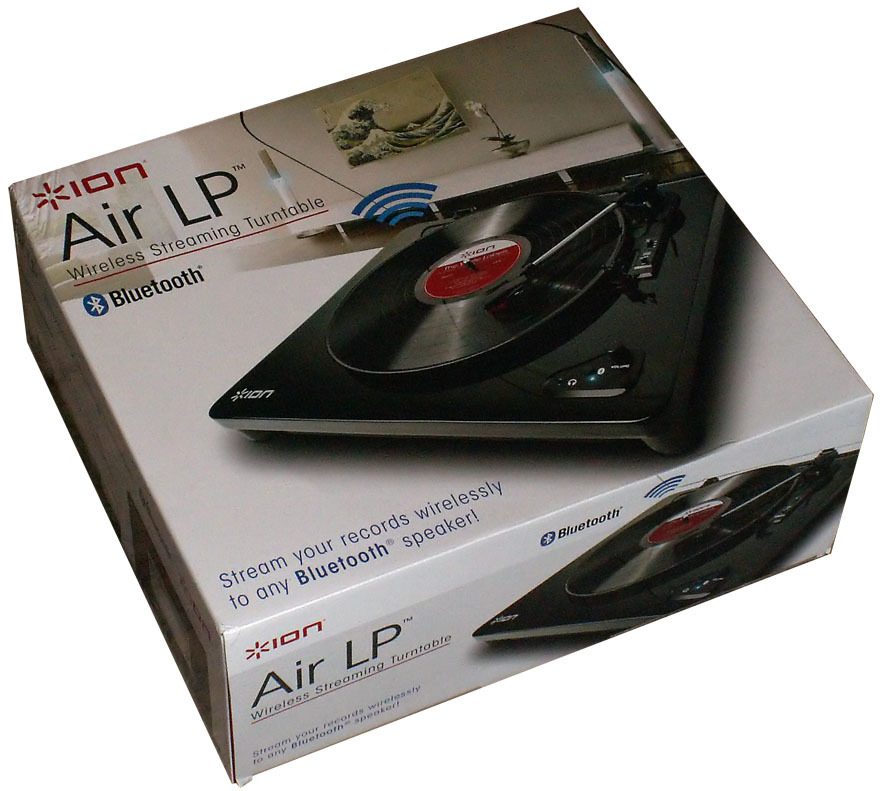
Unfortunately, there is no Russian language on the box - well, we are used to it!

Inside this box is already contained the actual player.
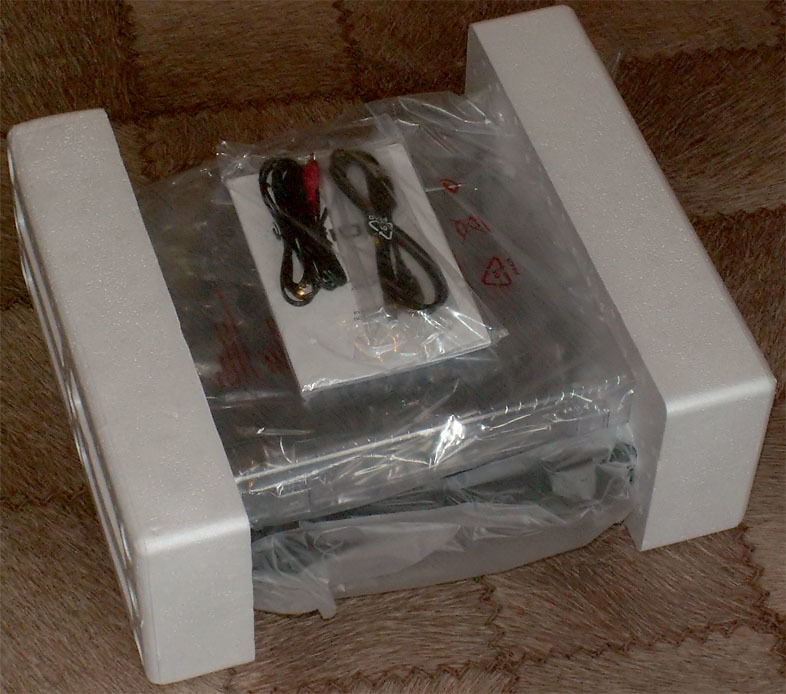
Traditional foam holders, a lot of plastic film, in separate bags - manuals and cords. Everything is traditional, reliable, neat.
The set includes, in addition to the player itself: a 12 volt power supply in the form of a power adapter, a USB AB cable, a tulip-tulip stereo cable, a line-in cable with 3.5 mm jack plugs at both ends, a CD disk with the program EZ Vinyl / Tape Converter, as well as three pamphlets: warranty information (in foreign languages), and two, they say, Quick Start, one for all European and the other purely for Russian. Moreover, pay attention to the fractional line in the name of the program - this is a direct hint that you can digitize not only from vinyl, but also, for example, from a tape recorder ...
The player is made in a strict black and transparent glossy style, which also causes nostalgia for top-class players that are inaccessible at that time. Yes, the body is not plastic, but MDF coated with "piano lacquer"!
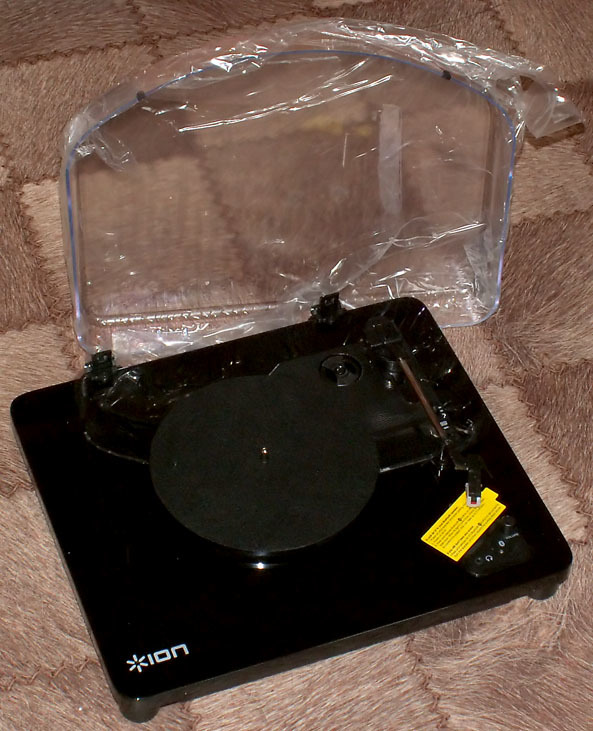
The lid is transparent, very transparent, such material is now called “acrylic”, and nowadays they were called simply “Plexiglas.”
For transportation, it is covered with a polyethylene protective film with the effect of “sticking” (not adhesive tape, peeled off without a trace!), Preserving the original gloss of acrylic.
The first thing that strikes you is a bright yellow sticker explaining how to use the Bluetooth button. The needle (cartridge) is covered with a removable plastic protection.
From the controls, except for the "twist" volume control are present: Bluetooth button, plate speed switch (there are all options: 33, 45 and 78 revolutions), auto-stop on-off lever and micro-lift, allowing you to gently lower and raise the "needle" on the plate . The tonearm in the “traveling” position is fastened with a special “latch”.
There is also a headphone jack, a standard 3 mm jack.
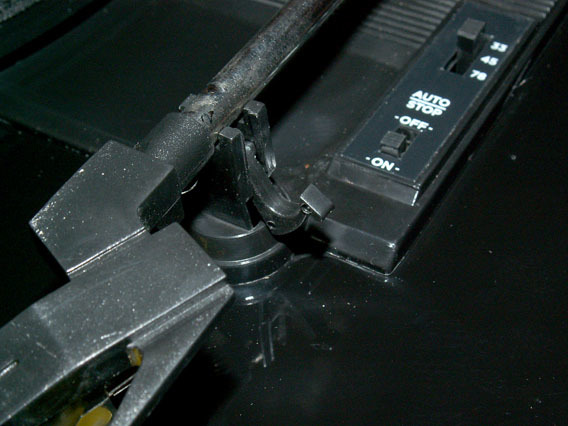
Bar tonarm - metal, the rest is all plastic. The microlift is higher, above the speed regulator (missed in the frame).
Needle full face:
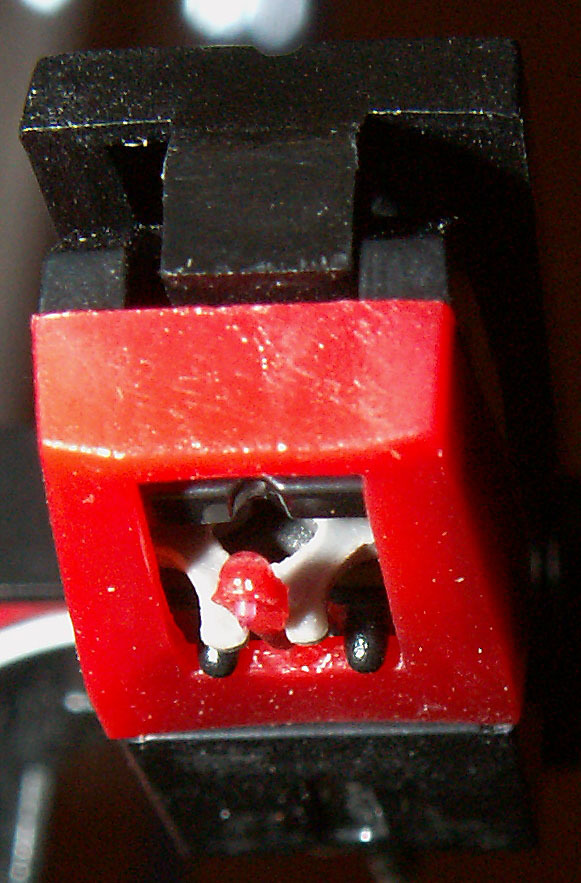
profile:
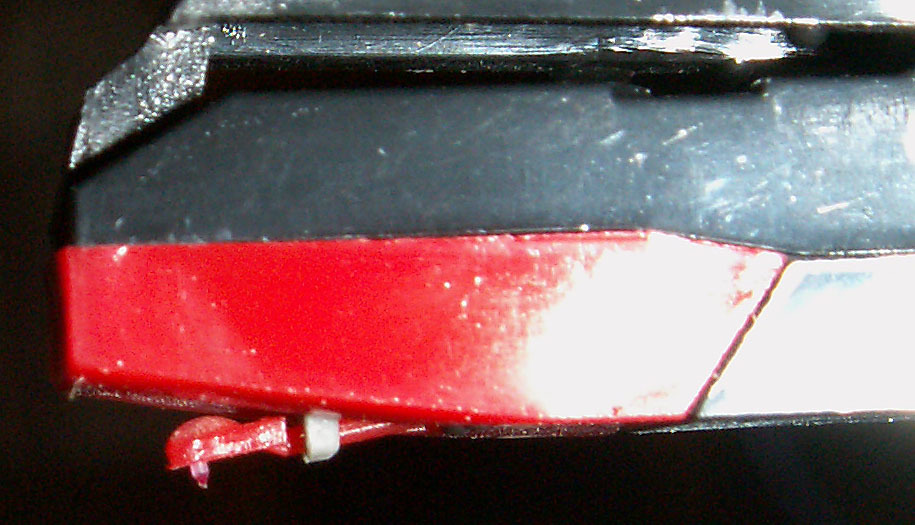
The red plastic is obviously a cartridge, something that in our time was called a “pickup.”
Actually the needle is transparent, diamond. In “our time,” it was an expensive rarity, corundum needles were more common, lower quality and durable ...
I will not remove the cartridge yet, since I still have nothing to change it for, but I have not figured out how to “click it off” (I don’t want to break it) ...
The pictures have a lot of bright spots on the plastic - these are reflections of the light from the flash, with the naked eye everything looks civilized and smooth.
There is a felt (some kind of non-woven material, pleasant to the touch) a round lining on the drive disk so that the plate is “to lie softly”.
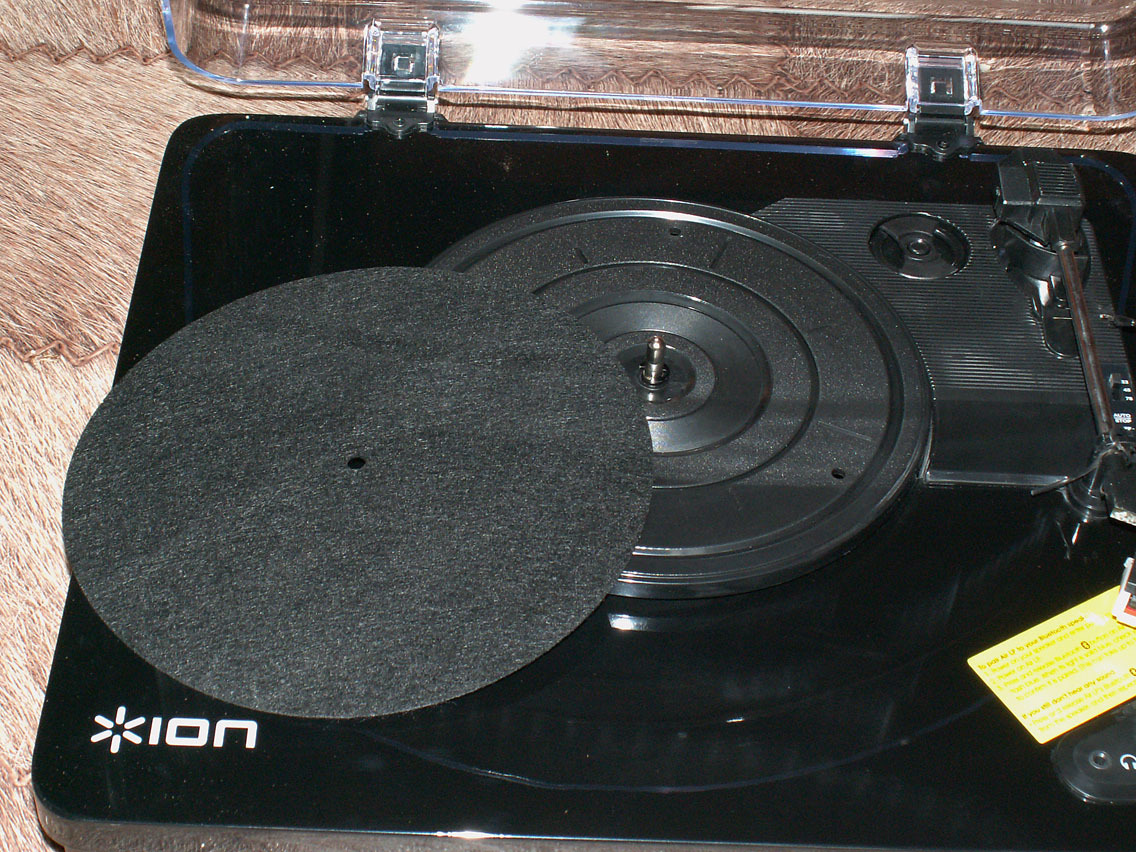
In the upper right corner, one can see a certain circular pattern - this is an adapter for 45-revolving plates with a large hole (judging by Wikipedia , there were discs with slots around the central hole, it was possible to break the “middle” to use such a disc in the jukebox). I have never been such).

This is how it is worn. Unlike the Soviet versions, it is not combined with a brush for cleaning records - but it’s even good, the temptation to “quickly wipe” the record will not be tempted, thereby spoiling it ...
It can be noted that the central pin of the drive does not rotate; it acts as a fixed axis on which the drive disc “rotates”.
The disc will be the disc widely known in narrow circles of the “Autograph” group, not overly erased, but not too new (well, what else can there be discs for an ordinary fan of “this business” - “rich Buratin” and audiophiles are not routinely discussed - not that class).

Since I’m too lazy to make a full machine for washing records (I don’t intend to devote my life to vinyl, there are many more - for me - interesting activities, for example, my keyboard ), the dough plate was slightly wiped with a lint-free napkin solution, then clean water - strictly along the tracks! - that is, in circular motions.
And so, with a sense of anticipation, the "tulips" of the "home theater" amplifier are connected, and - the exciting moment - the first launch!
Pay attention when you “stick in” the power supply connector - there, on the back, next to the socket there is an on-off button, I accidentally pressed it at the next connection, it turned off, and I wondered for a few minutes why the record was not spinning ...
Oh, it turns out, the rotation of the plate (with the auto-stop turned on) begins as soon as the needle is above the plate (when turned off, it rotates always while “plugged into the socket”)! Aha, but a microlift with smooth lowering of the arm (far from all “Soviet” “turntables” was like that)!
Excellent - plays !!! Moreover, exactly as the records should “play”. Immediately I recall the youth ...
Since my amplifier is tuned to a modern digital “electronic circuit”, the lack of high frequencies can be heard - they are muffled by mids (if you are interested, you can stop “wicking” about the vinyl characteristics). Although the “warm tube” hissing of the needle along the walls of the track and the rare remaining dust particles can be heard, of course, clearly ... That is, the player reproduces all sound frequencies without any problems, and “lifting up” the equalizer “on the top” (and, if desired, “on the bottoms "), You can get an approximate correspondence to the modern" bottle ".
I have already lost the habit of the “warm mechanical hissing” of the needle, so nostalgia manifests itself “in full growth”.
By the way, do you know the difference between a music lover (and vinyl in particular) from a real audiophile? The amateur listens to music, and audiophile - noises in pauses!
So, I will listen to music, exactly in this quality, which was in the days of my youth!
But the completely untouched record with the anthems of the USSR and the Union republics (well, whoever listened to them, “at the time”)! It sounds exactly the way our anthem should sound without any equalizer correction - there is no “electronic high”, symphony orchestra is power!
Also, I listened to several records through not the worst Soviet wired headphones, completely new multimedia “Svensky” headphones and through a bluetooth headset with which I listen to music from the phone - the sound is the same as through an amplifier, the first time there is not enough “high "(This is if you listen directly from the player through a special headphone output on the top panel). With the appropriate equalizer setting in my “home theater”, of course, everything becomes absolutely wonderful!
The plates "78" are also reproduced without questions, the quality is also quite decent (not counting the greater hiss of the needle due to the high speed of the needle moving along the path - that would be someone who invented to lubricate the plates, all the same "pair of dry friction" is obtained). As far as my memory fails, they also sound “100 per cent,” exactly as they sounded during the Soviet era. Moreover, the "socialist", and "april".
And the Istanbul foxtrot vividly reminded me of a film with Sean Connery in the role of James Bond “Never Say Never”.
To compare the playback quality, the player was taken home to a friend who was fond of vinyl (he has Arcturus-006, an amplifier 8.1 JVC and speakers S-90 + subwoofer - the equipment, of course, does not compare with my orphan "cinema"). Some of his most favorite records were listened to, alternately on his player and on ION-e - in the end, a friend was literally amazed by the quality, as he originally put it, “of this flat Chinese balalaika”!
Well, since the device allows you to digitally record the plates directly to the computer (via a USB cable), then, having installed the EZ Vinyl / Tape Converter program from the included CD-ROM, I digitized a couple of tracks. The program interface is a kind of "master" who without unnecessary gestures will guide the user through all the necessary points in order (the interface is only English, but there are literally three words, remembering them, if necessary, looking in the Google translator is not difficult).
The name of the album and artist is used by the program as a folder name for storing digitized tracks - by the way, it saves in wav format rather than mp3, in principle, it’s better for further processing, since wav format is “lossless” and mp3 is “ with losses "(what does this mean - Google to help, for the initial digitization and storage of intermediate processing results it is always better to use the" lossless "format, but the result is, of course, better stored in a more" running "format).
To view the spectrum of the signal and process the digitized compositions, I used the trial version of the excellent audio editor GoldWave. Below are the spectra (from left to right): the digitized signal of the first disc composition of the Autograph group (there is clearly a lack of high frequencies), the same composition after light processing (raised “up”, slightly “bottoms”, “crushed” noise, then - normalization level) and the spectrum of the same composition downloaded from the Internet (apparently, digitized on professional equipment). It can be seen that after processing the spectrum is much closer to the “professional” quality.

I can say that in my non-top class “home theater” I liked the composition more precisely in my processing (with all its processing — “clumsiness” and imperfection) than “professional”, somehow more “rich” music turned out, the professionals turned out too "dry", "sterile." Well, I already spoke like a real audiophile! But, really, “playing” with the settings of the audio editor, you can achieve the “new” sound of even familiar phonograms.
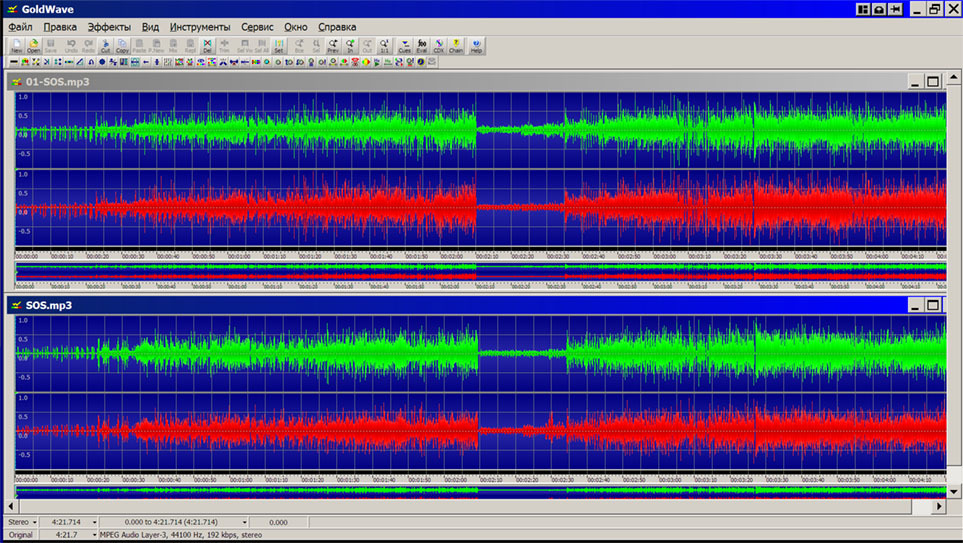
On the oscillogram, it turned out almost one-to-one.
So, I can assure you that the possibility of digitizing from this player is very cool, especially since the independent processing of sound in our time does not present any difficulties, the programs for this are the sea (there are also free ones), there is also the so-called “package "Processing, that is, you can put a plate, set the automatic separation of the tracks (such a" tick "is in the program EZ Vinyl / Tape Converter), and after the end set the automatic processing by the specified parameters (which will be enough to determine" manually "for only one album compositions) along with conversion to the now popular mp3 format, and get a ready-made collection “from vinyl” on the way out!
By the way, let me hint again: this player can digitize not only vinyl discs, but also any soundtracks from any equipment connected with a cord with two “jacks” at the ends (included!) With a linear output to the line input! That is, it is possible to digitize not only records, but also favorite tape recordings, for example (of course, they can be digitized and just “through the computer”, but everything is already adjusted, everything is there - work for your health).
Finally, I want to briefly recall (and young people - to tell) how to properly handle vinyl.
- First of all, it is necessary to store the plates in an upright position (in any case not a “foot”!). Too high and too low temperatures (room temperature is desirable) and high humidity are undesirable.
- Plastic bags - evil. Better paper ones. Polyethylene is electrified, which contributes to the accumulation of dust, which is everywhere and always.
- Wipe the plate should be strictly along the tracks, in a circular motion (although it is better, probably, to wash with a special contactless machine).
- You can remove dust from the plates in different ways, from buying (or making, there is nothing “cosmic”) for a special washing machine, and to removing dust with PVA glue (it is said that it does not wet the vinyl, but glues the dust, and after drying is easily removed as a film with dust). You can also clean the way I described above.
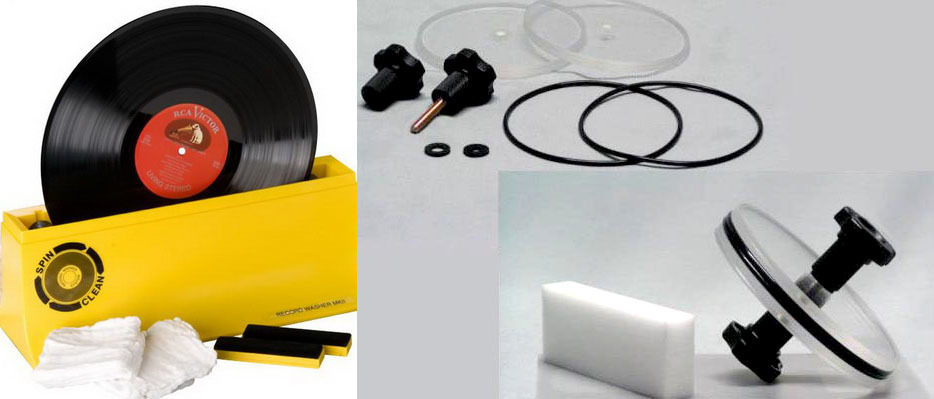
- With any method of cleaning, of course, you should avoid contact with detergent and water on the label.
- Special cleaning and washing compositions for washing machines and for manual washing of plates, despite all their “firmness” and high cost, are controversial, not all of them are suitable for all types of plastics from which the plate is cast, not all are well washed off and not always justify its price (there are often ordinary detergents diluted with water) - but here everyone is looking for the optimum for themselves ...
- In order not to “flirt” with a unique or just liked record, you can (and should!) Rewrite it to a more “stable” medium, and the ION Audio AIR LP player given in this review gives you all the possibilities! And before that I had to rewrite on a tape recorder ...
- Among the "Soviet" vinyl lovers, it was believed that when you first listen to the disc loses up to 25% of its resource, with the second - another 10%, well, and then - on decreasing. About 25% may be an exaggeration, but a new record is better to digitize immediately when you first listen (modern equipment and storage formats allow you to get an exact copy).
Well and, as a bonus to the review, I will give pictures of vinyl record tracks under a microscope (taken from the Internet). Dust is visible on the right image (before cleaning).
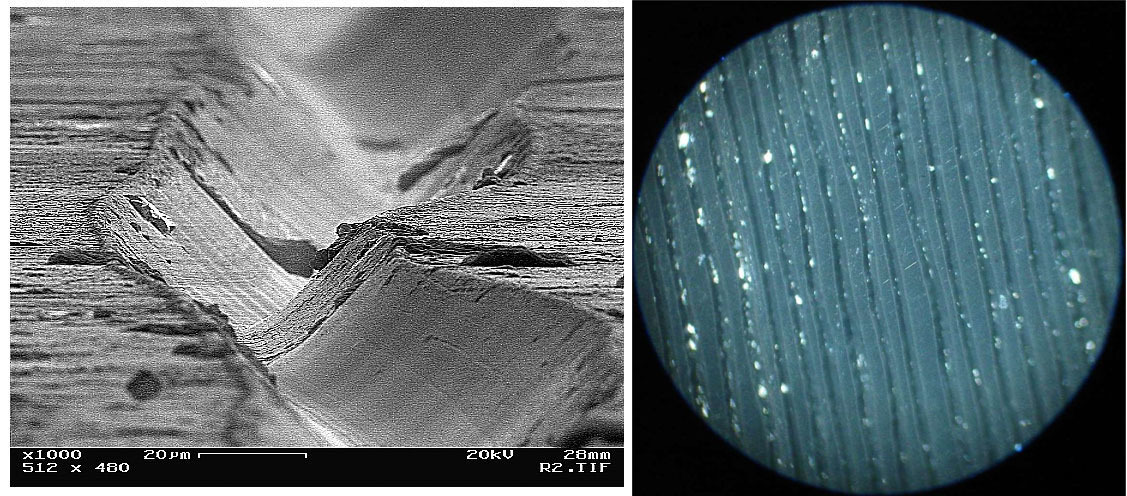
So, the main thing is said, the records are obedient-digitized, audiophile tendencies and nostalgia are satisfied - it's time to move on to conclusions.
And the conclusions - all only positive, oddly enough!
Advantages:
- price (for this technique - it is "penny");
- good sound quality;
- very, very decent and solid look;
- ;
- Bluetooth ( , « 1,5 » — , «́ » «» — ION Audio Pure LP);
- (33, 45 78 );
- ( );
- USB « »;
- ( . .);
- ( « 33 » ;
Disadvantages:
- but they are not, the player is inexpensive, and to demand parameters from it, the price of which starts from “polshtukievro”, is at least silly! Well, do not take the same significant disadvantage of the need for a small adjustment of the equalizer?
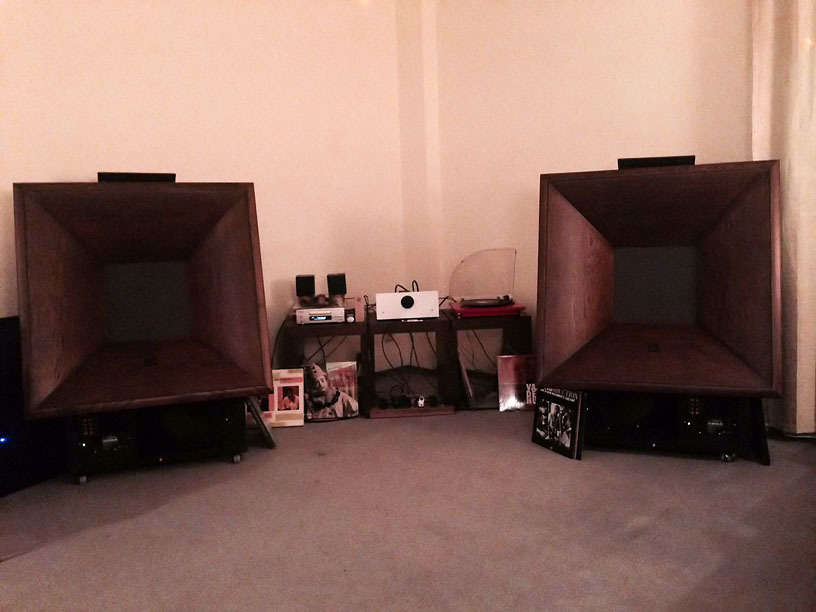
Source: https://habr.com/ru/post/369523/
All Articles